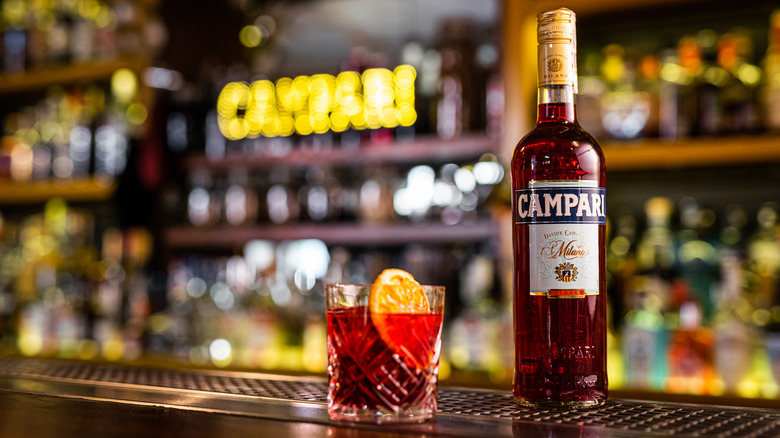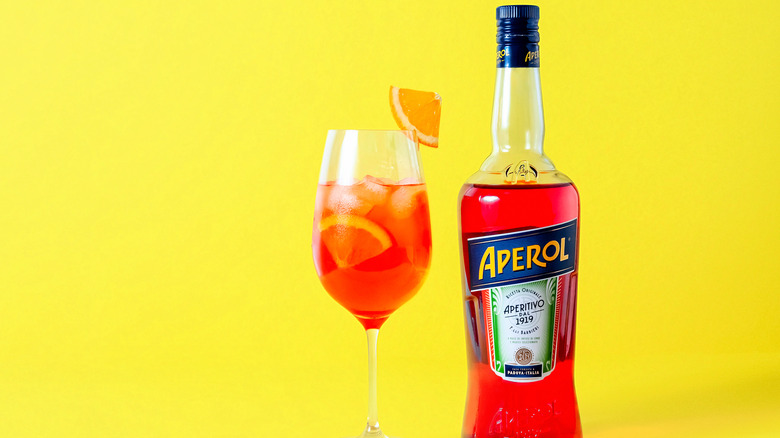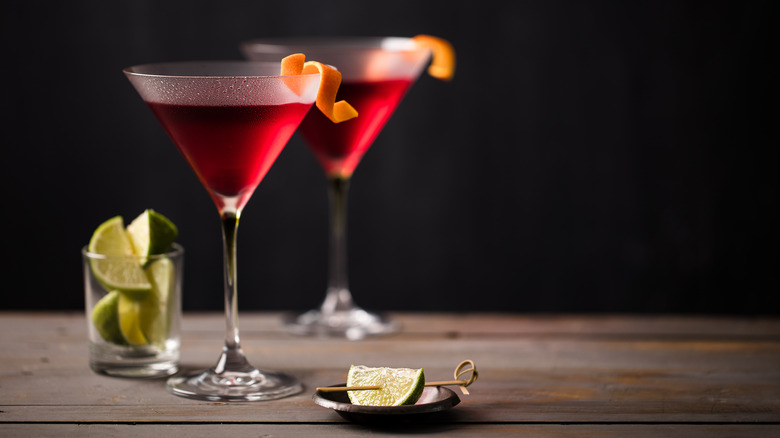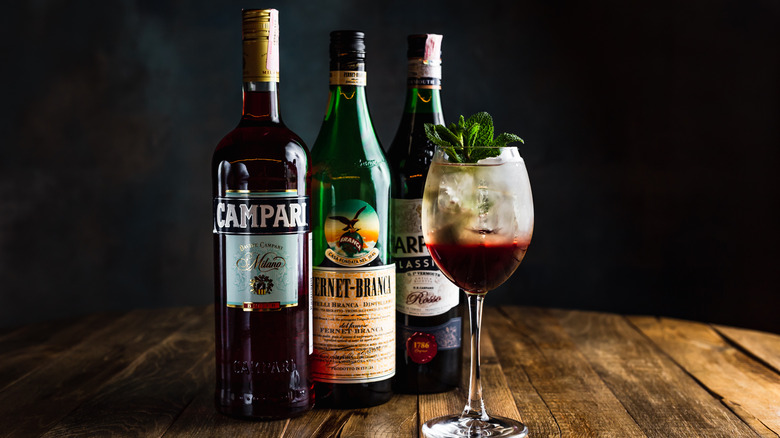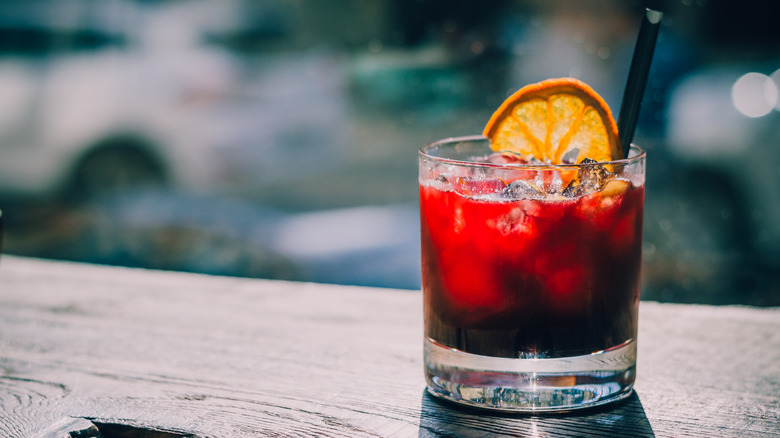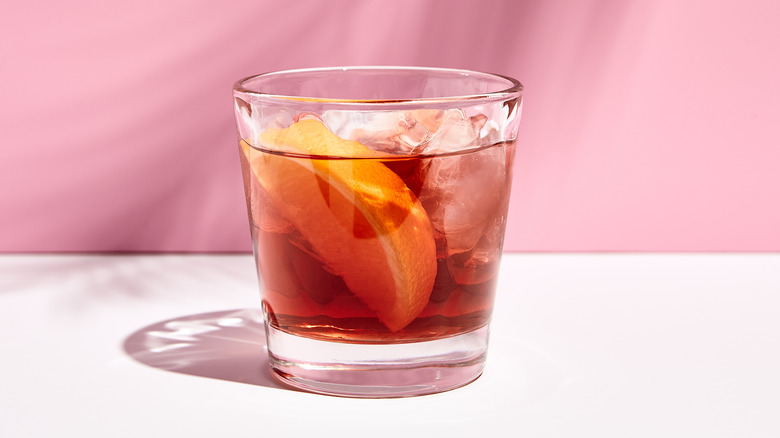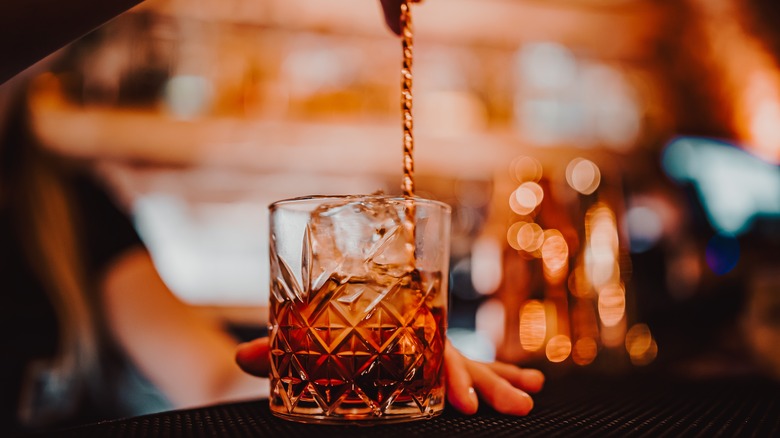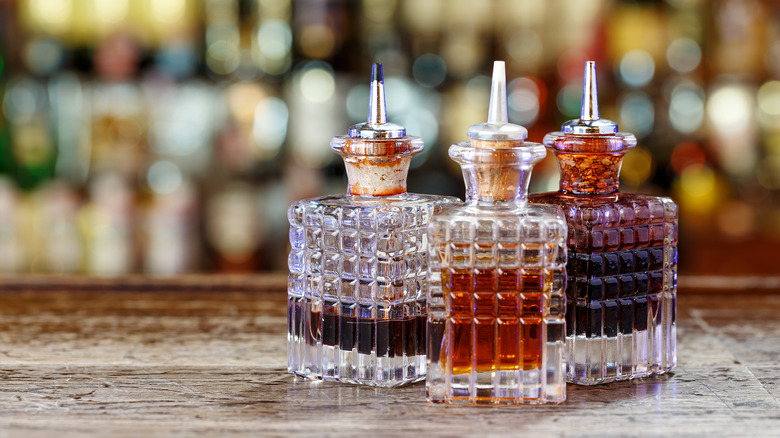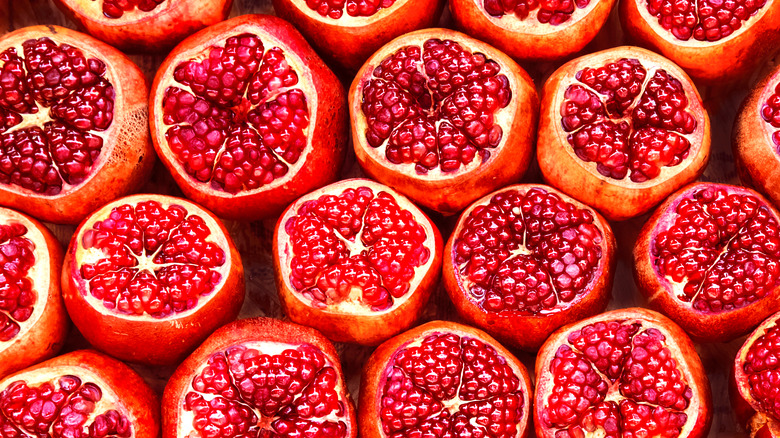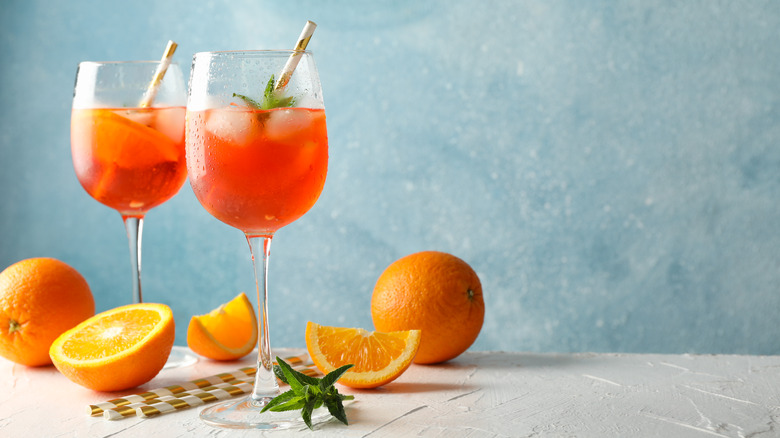10 Best Substitutes For Campari
Unless your drink of choice on any given night is a Negroni, or you have a particular fondness for apéritifs before a hearty meal, you might not think of Campari as a liqueur that is essential to your home bar. So, when a new cocktail that you want to try calls for an ounce or two of the stuff, chances are you'll be put off from making it. Rather than hunting for a Campari-free version or splurging on a brand-new bottle that you'll only use once, you could easily substitute Campari with other liqueurs, spirits, or even fruit juice in your drink!
Per The Spruce Eats, Campari is an Italian apéritif — that is, it's usually enjoyed before a meal. Bright red in color, it's made from a mix of herbs, plants, and fruits and has about 24% alcohol by volume. Because of the herbs used in its making, Campari has a distinctively bitter taste that can be described as similar to that of bittersweet orange with notes of cherry, cinnamon, and clove.
While the herbaceous apéritif tends to star in cocktails like the Negroni and Americano, it's also served as is with some ice. Depending on what it is that you're making and how you intend to enjoy your drink, you can always substitute Campari with other alcoholic and non-alcoholic options. However, because of its distinct taste, giving Campari a reputation as one of the most bitter liqueurs on the market, no substitute will be 100% the same. Nevertheless, here are 10 ideas that get close.
1. Aperol
As with Campari, Aperol is also an Italian bitter that is most often consumed as an apéritif before a meal (via A Couple Cooks). Because it is an apéritif and is of the same origin, it's the next best thing to swap in, says Substitute Cooking. Even Saveur goes as far as to call Campari and Aperol siblings!
When you're using Aperol, however, there are a few differences to keep in mind. For one, Campari is bright red in color whereas Aperol is a bright orange, so when you're using the latter, be prepared for a noticeable change in the appearance of your cocktail. Campari also happens to be very bitter in taste, more bitter than most other drinks. Aperol, on the other hand, is not just less bitter, but it's also sweeter with notes of citrus and herbs.
Aperol also has a lower percentage of alcohol with 11% ABV compared to the 24% that Campari packs. If you're looking for a substitute that is less bitter, more balanced, and not as boozy, it's a good alternative. You can use equal amounts to substitute Campari in your drink, but make sure to account for the sweeter taste and lower percentage of alcohol.
2. Contratto Bitter
Another Italian apéritif that is similar to both Campari and Aperol is Contratto Bitter. Per Food & Wine, Campari drinkers that like the red apéritif for its herbaceous flavor will like Contratto Bitter because it's just as rich and complex, but is less bitter in taste. It's made from an Italian grape brandy base that is infused with at least 24 botanicals, a mix of herbs, spices, roots, and seeds (via the Contratto website). It is equally bright red in color and gets its hue from carrot and beetroot extract.
Because both Campari and Contratto are red in color with a similar herbal flavor, Contratto makes for an excellent substitute, especially if you're making cocktails like the Negroni. Thrillist says that the bitter is rounded enough to go nicely in a Negroni made with gin that is juniper heavy, or in a Boulevardier with a rye whiskey that has notes of pepper. You can substitute Campari with equal amounts of Contratto Bitter in your cocktail.
3. Fernet Branca
Campari and its sibling Aperol are both Italian bitters, belonging to a group of herbal liqueurs also known as amaro, literally meaning "bitter" in Italian. Fernet Branca also happens to be an amaro — much like Campari — making it a suitable substitute (via A Couple Cooks).
Fernet Branca is just as bitter in taste as Campari and has a profile similar to black licorice but with a sweet finish. Made from a blend of 27 herbs and spices, it was originally created in Milan in 1845 to be used as a medicinal tonic and has a slightly minty taste (via Liquor). Similar to Campari, Fernet Branca has a red-colored hue but happens to be boozier than its counterpart, with 40-45% of alcohol by volume. That's far more than most liqueurs and is almost equal to the alcohol percentage that spirits like vodka contain.
Substitute Cooking suggests swapping Campari with Fernet Branca using a 1:1 ratio, but warns that your drink will taste noticeably different, and it will also have a lot more alcohol.
4. Martini & Rossi Riserva Speciale Bitter Liqueur
If it's a Negroni that you love to drink but simply don't like the taste that Campari adds to it, Martini & Rossi's Riserva Speciale Bitter Liqueur can be a good alternative. The famous alcohol company whose vermouth the world wouldn't be able to imagine making a martini without, came out with a bitter liqueur only a few years ago (via Food & Wine).
Made with an 1872 recipe by proprietor Luigi Rossi himself, the Riserva Speciale Bitter has a stronger aroma than Campari but is also smoother, more well-rounded, complex, and a tad spicy. Food & Wine says that any cocktail you'd make with Campari is likely going to be just as good when made with Martini & Rossi's bitter liqueur. Per Thrillist, using it will create drier and stronger Negronis than when using Campari, and it will be less sweet. The liqueur though does have notes of honeycomb and candied orange rind as well as the spice of white pepper. You can use a 1:1 ratio to make the swap in your cocktail recipe.
5. Luxardo Bitter Rosso
Luxardo, famous for Maraschino cherries, also makes an Italian bitter that Vinepair finds to be a great substitute for Campari. Luxardo's Bitter Rosso is red in color, similar to the bright red hue of Campari, and is made from a blend of water and alcohol infused with herbs, aromatic plants, and citrus fruits. It has an herbaceous flavor and a citrusy aroma, which the maker suggests goes well in a Negroni or an Americano cocktail.
Thrillist says that Luxardo Bitter Rosso's citrus flavor, with a subtle sweetness and creamy mouthfeel, also fairs well in cocktails where Campari was otherwise meant to shine. Greg Titian, the host of the YouTube show "How To Drink" likewise vouches for Luxardo Bitter Rosso's suitability in place of Campari in cocktails. He claims that after trying several alternatives, he found that Luxardo's option was "nearly identical" and believes it's one of the best substitutes to use in place of the bitter Italian apéritif. Titian suggests that Luxardo Bitter Rosso can be used interchangeably with Campari in a cocktail using a 1:1 ratio.
6. Meletti 1870 Bitter Aperitivo
If you're going to be substituting an Italian apéritif like Campari, it's a no-brainer that another Italian apéritif is going to be the next best thing. Luckily, there's no shortage of them in the market! Per Punch, Meletti's 1870 Bitter is a great choice. It launched in the U.S. in 2015 thanks to an old, forgotten family recipe that combines three separate distillates: sweet orange, bitter orange, and an infusion of spice and herbs. The result is a red-colored apéritif that is mildly bitter with notes of citrus and spices. Drinkhacker even calls the Meletti 1870 a Campari lookalike!
While it can be used as an alternative to Campari in cocktails, the site notes there are certain differences between the two apéritifs. The most obvious is the bitterness. Campari is regarded as one of the most bitter liqueurs to exist and so, there's no match for the heavy pucker it adds to a cocktail. Meletti's 1870 Bitter, on the other hand, is fruity and spicy, which only finishes off with a slightly bitter flavor. You can use the Meletti 1870 Bitter Aperitivo the same way as you would use Campari in your cocktail in a 1:1 swap.
7. Cappelletti Aperitivo Americano
The Cappelletti Aperitivo Americano is also an Italian apéritif but it has an edge over Campari and other substitutes in that it's made from a base of wine. Even Food & Wine calls it Campari's sibling, except, it is much easier to drink. This is because Cappelletti Aperitivo is still herbal and bitter, similar to Campari, but with a touch of sweetness. The red-colored drink also has a lower alcohol percentage compared to Campari, which can be a pro or con, depending on how you look at it.
According to Thrillist, although this Campari counterpart has a bitter flavor reminiscent of orange and strawberry jam, it's also rich, velvety, and fruity thanks to its wine base. This gives Cappelletti Negronis a fruity complexity that Campari Negronis lack. Food & Wine says that Cappelletti Aperitivo can be drunk as is or with a splash of soda and orange to brighten the flavor. Use it in equal amounts to substitute Campari in a cocktail.
8. Homemade Bitters and DIY Campari
Since Campari is a type of Italian bitter, you could always substitute it with a homemade bitter. The best part about making your own is that you can customize the flavor as much as you like! Per Substitute Cooking, all you need is a bottle of vodka and a bunch of herbs and spices that you like. It could be as simple as vanilla, cinnamon, and star anise for flavor — or something more complex and punchy, such as the addition of cayenne.
According to Simply Recipes, you can even make your own Campari in a similar way. The key is to use a clear spirit like vodka that is at least 150 proof or higher. Then, make sure to use ingredients like ginseng and wormwood that will add bitterness; citrus peels for flavor; food coloring for appearance; and simple syrup for sweetness. The site also suggests that homemade bitters or Campari can be more affordable because you can make several bottles for the same price as one bottle from the store.
The Spruce Eats adds that homemade Campari can be used in cocktails just as you would use the store-bought one, in a 1:1 ratio.
9. Pomegranate Juice
If you're on the fence about mixing an already strong liqueur with an even stronger spirit in cocktails like the Negroni and Americano, a non-alcoholic substitute for Campari might do the trick. Per Substitute Cooking, one recommendation is pomegranate juice, which will not only add the desired red color, but it also has a similar bitter taste.
In cocktails like the Americano, which requires all but two ingredients — vermouth and Campari — swapping either one of them can be tricky. Serious Eats suggests that two ounces of pomegranate juice along with two dashes of Angostura bitters will make an Americano just as acidic, bitter, and sweet as if it was made with vermouth and Campari. If you're looking for an entirely non-alcoholic drink, aka one without the Angostura bitters, you can also use grenadine, which is a sweet and tart red-colored syrup made from pomegranate juice (via All Recipes). Per Gourmet Sleuth, you can use equal amounts of pomegranate juice with a dash of bitters to substitute Campari in your recipe. For grenadine syrup, use half the amount of pomegranate juice that you would use as it tends to be a lot sweeter.
10. Lyre's Non-Alcoholic Italian Orange Spirit
It's been a good few years for non-alcoholic drinkers. Thanks to company's like Australia-based Lyre's, which makes non-alcoholic spirits including an alcohol-free version of Campari, it's no longer unimaginable to shake a cocktail that is made without any alcohol.
Per Lyre's website, their Non-Alcoholic Italian Orange Spirit is "crafted to capture the essence of a bitter orange apéritif such as Campari." The non-alcoholic spirit has notes of blood orange and red citrus of course, but also the dryness of Maraschino cherries. For $35.99 a bottle, Lyre's suggests that the Italian Orange Spirit can be drunk as an Italian apéritif with soda and tonic water, or used in cocktails like the Negroni where Campari would otherwise be needed.
According to Master Of Mocktails, when making a non-alcoholic Negroni or Boulevardier with Lyre's Italian Orange Spirit in place of Campari, the drink can turn out to be a tad too sweet. Instead, the spirit works as a better substitute for Campari in an Americano, says the site. Or just make sure to adjust the proportions to get the flavor profile you desire.
